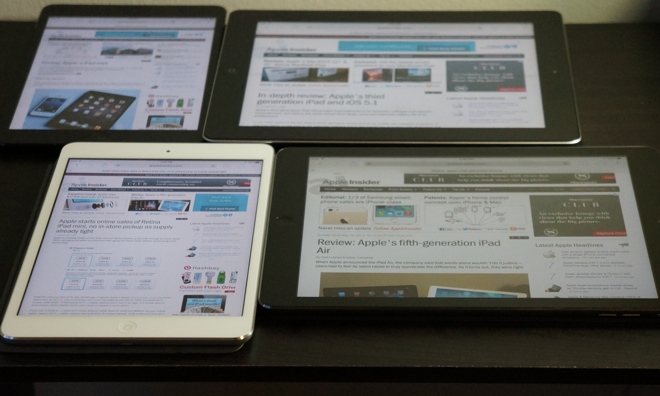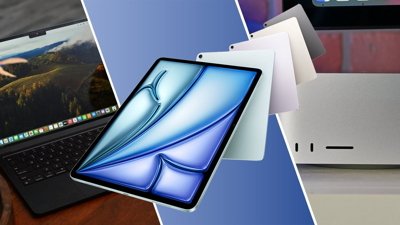Apple's second-generation iPad mini squeezes a high-resolution Retina display — one with an even greater pixel density than the iPad Air — into its diminutive form factor. It's an impressive technical achievement, but one that comes at a greater cost to customers.
Released this week in time for the holiday shopping season, the new iPad mini with Retina display starts at $400 for the 16-gigabyte Wi-Fi only model. Capacity can be doubled, all the way up to 128 gigabytes, at $100 increments, while cellular-capable models carry a $130 premium.
Those prices are $70 more than Apple sold the first-generation iPad mini for when it debuted a year ago. But the extra cost is attributed to the device's new high-resolution display, which features the same number of pixels as the iPad Air screen, while packing them into a much smaller 7.9-inch size.
The Retina iPad mini also comes in two color options: a "space gray" aluminum back with a black front, and a "silver" model with white front. For this review, our test model was the entry-level, Wi-Fi-only 16-gigabyte model in white and silver.
Retina display
The addition of the Retina display to Apple's iPad mini is not unlike when the company first introduced a Retina display in the full-size third-generation iPad. The design remains the same, though Apple has had to sacrifice some weight and thickness to drive a much greater pixel count.
The Retina display in the iPad mini is a much greater technical achievement, though. Apple has managed to retain the same resolution as the full-size iPad Air, allowing developers to create applications at one screen resolution and have them instantly compatible with both the iPad Air and iPad mini.
One look at the iPad mini's display is all it takes. This is a truly impressive screen that makes text much easier to read and general usage far more pleasant.
Comparing the Retina iPad mini side-by-side with Apple's first-generation model only emphasizes the improvements even more. While text on the first iPad mini is muddy and pixelated, it's crisp and clear on the Retina iPad mini.
The Retina display alone makes the second-generation iPad mini a worthy successor. It addresses the one major failing of Apple's introduction to the smaller tablet market in 2012, and it does so impressively.
But while the Retina display is the only significantly noticeable outward-facing change with the second-generation iPad mini, Apple has also made significant improvements on the inside with its 2013 refresh.
Performance
Apple is once again flexing its chipmaking muscles with the new iPad mini, bringing the same A7 chip the company has already offered in this year's iPhone 5s and iPad Air. And once again the A7 manages to impress, driving the device's high-resolution screen and running gorgeous applications without so much as a hiccup.
It's worth noting that the inclusion of the A7 chip in the second-generation iPad mini is an even more significant upgrade than this year's iPhone and full-size iPad saw. That's because last year's iPad mini was driven by the two-generations-old A5 chip, meaning the inclusion of the A7 chip offers an even larger performance boost.
Tests show that the new iPad mini's processor gives it 5 times more power than last year's first-generation iPad mini. In comparison, the iPad Air is twice as powerful as the fourth-generation iPad.
Of course, the A7 chip is somewhat of a necessity in this year's iPad mini simply because of the Retina display. Driving that many pixels is taxing on a processor, as evidenced by the sometimes sluggish A5X chip performance seen with Apple's third-generation full-size iPad — the first iPad to have a Retina display.
Thankfully, Apple didn't skimp out on this year's model, and gave the iPad mini a processor that's powerful enough to push those more than 3 million pixels displaying iOS 7, and presumably future software updates from the company for years to come.
The 64-bit A7 CPU in the new iPad mini is clocked in at 1.3 gigahertz, which is slightly slower than the iPad Air's 1.4 gigahertz, to conserve battery life. In our comparisons, any performance differences between the iPad Air and Retina iPad mini were negligible, with apps launching at about the same speed and websites loading around the same time.
Design
The power of the new iPad mini has necessitated some subtle design changes. The new model is ever-so-slightly thicker and heavier than last year's model, but frankly these changes will be unnoticeable to most users.
The Retina iPad mini is 7.5 millimeters thick, which is 0.3 millimeters thicker than the first-generation model. The new iPad mini also weighs in at 331 grams, which is an increase from the 312 grams of last year's version.
Unless a user is holding a first- and second-generation iPad mini in their hands simultaneously, these changes will not be readily apparent. We view the added heft to ensure long battery life as perfectly acceptable, given the inclusion of the powerful A7 chip and beautiful Retina display.
The only other noteworthy change to the external design of the iPad mini is the inclusion of dual microphones. Like the iPad Air, the new iPad mini features one microphone on the rear of the device, for better sound when recording video, and one up top, for hearing a user's voice when using FaceTime video chat.
The cameras on the iPad mini remain the same: a 5-megapixel rear facing iSight camera, and a 1.2-megapixel forward facing FaceTime HD lens.
And the rest of the iPad mini's design remains the same, with stereo speakers and a Lightning port on the bottom, volume buttons and a mute/rotation lock switch on the right side, and a lock button and 3.5-millimeter headphone jack up top.
Like the iPad Air, the Retina iPad mini also lacks the Touch ID fingerprint sensor Apple introduced on the iPhone 5s. This feature will likely appear in a future iPad mini update, but we believe it would be better aided on the iPad lineup by the addition of multi-user support in iOS.
Finally, because the design is largely unchanged, any of Apple's Smart Cover and Smart Case accessories work perfectly fine with the second-generation tablet. Accordingly, third-party cases and accessories should also continue to fit the new model.
Conclusion
While Apple got almost everything right with the Retina iPad mini, there is a catch: The cost for every model has increased by $70 from last year's prices. The starting price for the iPad mini with Retina display is now $400.
And while Apple's iOS ecosystem is unparalleled, the cost for hardware does not compare favorably with the iPad mini's chief competition. For example, Amazon's new Kindle Fire HDX sports a comparable high-resolution display, though it's smaller at just 7 inches diagonally in a 16:9 ratio.
Amazon's offering starts at just $229 for a 16-gigabyte model with "special offers." Removing ads from the entry-level Kindle Fire HDX puts the price at $244, or still more than $150 cheaper than Apple's cheapest iPad mini.
Google's latest Nexus 7 also has a high-resolution display at a smaller 7-inch 16:9 screen size than the iPad mini. It starts at $229 for the 16-gigabyte model, and a maxed-out 32-gigabyte Nexus 7 with 4G LTE connectivity can be had for $349 — $50 cheaper than Apple's Wi-Fi-only 16-gigabyte Retina iPad mini.
To counter this, Apple continues to offer the first-generation 16-gigabyte iPad mini for $299. This is a compelling option, but the lack of a high-resolution Retina display makes this tablet difficult to recommend.
Frankly, we feel the relatively premium pricing on the Retina iPad mini is worth it, though Apple does get dinged for being considerably more expensive than the competition.
But with a form factor ever so slightly thicker and heavier than last year's model, the new iPad mini does not feel like a revelation in your hands — unlike the drastically redesigned, thinner and lighter iPad Air. In the current marketplace, the iPad Air is clearly head and shoulders above every other tablet in its class, while the iPad mini faces more aggressive competition with cheaper prices in its market segment.
That said, Apple's iPad mini with Retina display remains an easy recommendation. It features best-in-class software and hardware, and is backed by the strongest mobile ecosystem available.
Score: 4.5 out of 5
Pros:
- Apple's Retina display standard once again lives up to the hype
- The 64-bit A7 chip's performance impresses, just as it did on the iPad Air & iPhone 5s
- Same great lightweight, ultraportable design as last year
Cons:
- Though lower-priced competition continues to improve, Apple has increased the iPad mini price by $70
- Limited supply could make the Retina iPad mini hard to get for the holidays
- Some may want to wait for Touch ID in a future model
 Neil Hughes
Neil Hughes












-m.jpg)


-m.jpg)






 William Gallagher
William Gallagher
 Christine McKee
Christine McKee
 Andrew O'Hara
Andrew O'Hara
 Mike Wuerthele
Mike Wuerthele



 Malcolm Owen
Malcolm Owen







148 Comments
The almost perfect tablet. Next year it will be perfect with TouchID. Still, it will sell tens of millions
Both google and amazon lose money on every tablet they sell. This is not a business model Apple is about to compete with in pricing.
Limited supply => high price
"While text on the first iPad mini is muddy and pixelated, it's crisp and clear on the Retina iPad mini." Something tells me that if I look up the review of the first iPad mini. the words "muddy and pixelated" will appear nowhere within... Ok, went back to the [URL=http://appleinsider.com/articles/12/11/06/review-apples-ipad-mini/page/2]original review[/URL] and found this: [QUOTE]To achieve this light and thin design at a reasonable cost, Apple didn't include a Retina Display. However, because the screen is reduced in size,[I] it delivers better screen sharpness and less obvious pixelation than iPad 2[/I], which shares the same resolution at a lower pixel density (iPad mini is 163 ppi vs iPad 2's 132 ppi). The result is that, while the iPad mini doesn't have the razor sharp, "electronic glossy magazine" appearance of the Retina display iPad, it's also [I]noticeably less pixelated looking than the original iPad[/I]. It's hard to accurately capture this in a photograph without minimizing or exaggerating the difference, but below you can see the difference between a standard iPad (top), Retina display iPad (middle) and the iPad mini. [/QUOTE] Things that make you go hmmm....
I do wish Apple would price the memory jumps in $50 increments rather then $100.